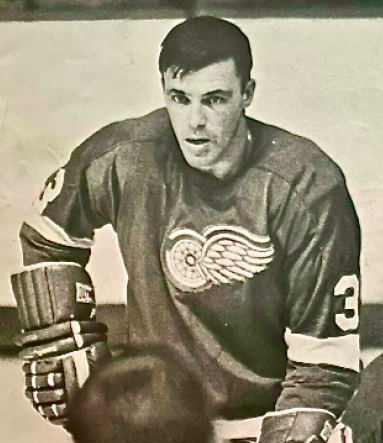IMAGE INFORMATION
EditAuseline Jean-Guy Talbot - Born July 11, 1932 in Cap-de-la-Madeleine, Quebec - Died February 22, 2024 was a Canadian ice Hockey defenceman, coach and general manager.
- Edinburgh Trophy Champion 1955 with Shawinigan Falls Cataracts.
- Quebec Hockey League President's Cup Champion 1954 with Quebec Aces, 1955 with Shawinigan Falls Cataracts.
- Stanley Cup Champion 1956, 1957, 1958, 1959, 1960, 1965, 1966 with Montreal Canadiens.
Stanley Cup finalist 1968, 1969, 1970 with St. Louis Blues.
- Prince of Wales Trophy Champion 1956, 1958, 1959, 1960, 1961, 1962, 1964, 1966 with Montreal Canadiens.
- Clarence S. Campbell Bowl Champion 1969, 1970 with St. Louis Blues.
- Lester Patrick Cup Champion 1972 with Denver Spurs (coach).
Talbot played junior Hockey for the Trois-Rivieres Reds and the Shawinigan Cataracts before playing senior Hockey with the Quebec Aces from 1952 to 1954..
After scoring 34 points for the Shawinigan Cataracts, now in the QHL in 1954-55, the talented rearguard was placed on the QHL's first all-star team. Talbot also made his NHL debut with Montreal Canadiens on February 13, 1955 at Madison Square Garden in a 4-1 Rangers win. Playing the 1st of 3 games for the Montreal Canadiens. He got 1 assist in the second game at the Montreal Forum.
Talbot then gained a regular job on the Montreal Canadiens' blueline for the 1955-56 season, scoring his 1st NHL goal on January 22, 1956 vs Hank Bassen of the Chicago Black Hawks at 4:42 of the 3rd in a 6-2 Canadiens victory. Talbot would enjoy Stanley Cup championships in each of his first five NHL seasons, a feat shared only by teammates Henri Richard, Claude Provost and Bob Turner. Led by Rocket Richard and Jean Beliveau, the Montreal Canadiens won the first of five consecutive Stanley Cup championships in 1955-56.
“I didn’t know anything other than what it was like to win it all every year those five seasons,” Talbot said. “That had to be one of the best teams of all-time. A whole group of us (12) stayed together for all five Cups.”
Talbot broke in as the Canadiens No. 5 defenseman and had great blueline role models in Doug Harvey, Butch Bouchard and Dollard St. Laurent. He was known for physical play and being an adept passer from Day 1.
Talbot was an integral part of the Canadiens transition game until 1966-67. His consistent play at both ends of the ice was crucial when the Canadiens had to replace the likes of Rocket Richard, Doug Harvey, and Bernie Geoffrion. After scoring 47 points (5 goals) in the 1961-62 season, Talbot was voted on to the NHL First All-Star team. Talbot also played an important role on Stanley Cup championship teams in 1965 and 1966.
When the Canadiens wanted to go with younger players like Serge Savard, he was left unprotected in the 1967 Expansion Draft. The Minnesota North Stars called his name in the draft, but ended up trading him to the Detroit Red Wings four games into the 1967-68 season. Before the end of the regular season schedule, Talbot was picked up by the St. Louis Blues. His puck handling and experience helped the club reach the Stanley Cup final three straight years beginning in 1968.
It was with the Blues that Talbot was involved in one of the seminal moments in Hockey history. In overtime of the 1970 final, Talbot was checking Bobby Orr in the corner when a give-and-go with Derek Sanderson resulted in Orr firing the puck past St. Louis goalie Glenn Hall. As Orr got lofted into the air off the stick of Blues defenseman Noel Picard, Talbot had a front-row seat. Watch it on YouTube and you’ll see No. 17 Talbot in a white helmet cruising behind the Blues net.
“I had the best vantage point of all,” Talbot said. “It all happened right there in front of me.”
Talbot was traded to the Buffalo Sabres in November 1970, and retired after the 1970-71 NHL season which he played 57 games for Buffalo.
Talbot played in 1,066 regular season NHL games, scoring 43 goals (8 GWG), 242 assists with 1014 penalty minutes, and 151 NHL playoff games, scoring 4 goals and 26 assists and 142 penalty minutes.
Talbot played in NHL All-Star Games 1956, 1957, 1958, 1960, 1962, 1965, 1967.
Talbot was selected to the 1962 NHL First All-Star Team.
Talbot became a coach after retiring. He coached the Denver Spurs to the Western Hockey League / WHL championship in 1972 (The Spurs became the first professional sports team in Colorado to win a championship - The Lester Patrick Cup) then worked behind the St. Louis bench on an interim basis, replacing Al Arbour who had been fired from the position. He held the position for two years, resigning in February 1974. Talbot signed on as head coach for the New York Rangers in 1977, taking over from John Ferguson, with whom he had played during his tenure with the Canadiens. As coach of the Rangers, Talbot was known for wearing a warmup suit behind the bench during games, rather than the normal business suit worn by most coaches.
“I asked (GM) John Ferguson ‘Will you let me wear a tracksuit during games? They’re looser and more comfortable. After a game, I take a shower and it feels good to put on a clean, dry suit instead of one that’s damp from the sweat.’ I think John felt bad for me so he didn’t argue with it. He let me do it for the last half of the season.”
That turned out to be one of Hockey's biggest fashion faux pas.





































